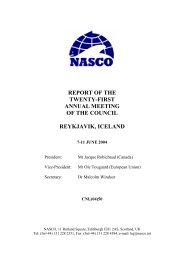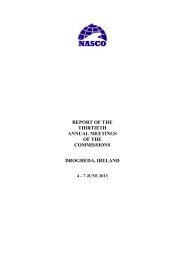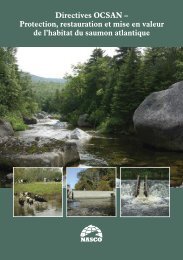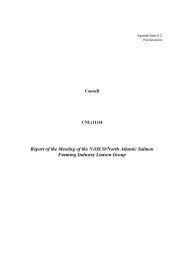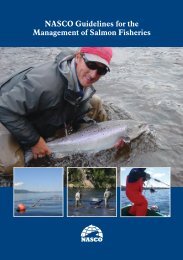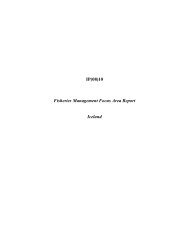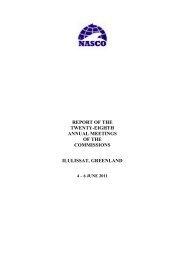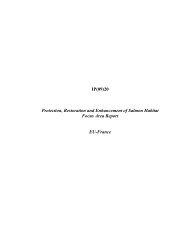Report of the 2005 ICES/NASCO Symposium on Interactions ...
Report of the 2005 ICES/NASCO Symposium on Interactions ...
Report of the 2005 ICES/NASCO Symposium on Interactions ...
You also want an ePaper? Increase the reach of your titles
YUMPU automatically turns print PDFs into web optimized ePapers that Google loves.
NINA SPECIAL REPORT 34<br />
We have to deal more with <str<strong>on</strong>g>the</str<strong>on</strong>g> matter <str<strong>on</strong>g>of</str<strong>on</strong>g> size in future<br />
regulati<strong>on</strong>s. Research, industry and public authorities have<br />
to c<strong>on</strong>tinue <str<strong>on</strong>g>the</str<strong>on</strong>g> good work toge<str<strong>on</strong>g>the</str<strong>on</strong>g>r at arenas like this<br />
symposium - so that we can avoid being outmanoeuvered<br />
by <str<strong>on</strong>g>the</str<strong>on</strong>g> law <str<strong>on</strong>g>of</str<strong>on</strong>g> large numbers.<br />
I would like to acknowledge <str<strong>on</strong>g>the</str<strong>on</strong>g> excellent work carried<br />
out in <str<strong>on</strong>g>the</str<strong>on</strong>g> Hardangerfjord area. The outstanding results<br />
with regard to salm<strong>on</strong> lice will hopefully be matched with<br />
regard to <str<strong>on</strong>g>the</str<strong>on</strong>g> escapement problem. The secret: focused<br />
research, communicati<strong>on</strong> and coordinati<strong>on</strong>.<br />
We must all work hard to minimise <str<strong>on</strong>g>the</str<strong>on</strong>g> negative aspects<br />
<str<strong>on</strong>g>of</str<strong>on</strong>g> fish farming with a faster tempo than <str<strong>on</strong>g>the</str<strong>on</strong>g> growth rate<br />
<str<strong>on</strong>g>of</str<strong>on</strong>g> <str<strong>on</strong>g>the</str<strong>on</strong>g> salm<strong>on</strong> farming industry. The risk <str<strong>on</strong>g>of</str<strong>on</strong>g> escape per<br />
salm<strong>on</strong> in captivity should be reduced more than <str<strong>on</strong>g>the</str<strong>on</strong>g><br />
increase in numbers reared in captivity, in order to reduce<br />
<str<strong>on</strong>g>the</str<strong>on</strong>g> number <str<strong>on</strong>g>of</str<strong>on</strong>g> escapees. The reducti<strong>on</strong> in <str<strong>on</strong>g>the</str<strong>on</strong>g> number <str<strong>on</strong>g>of</str<strong>on</strong>g><br />
gravid salm<strong>on</strong> lice per fish in a farm should exceed <str<strong>on</strong>g>the</str<strong>on</strong>g><br />
increase in <str<strong>on</strong>g>the</str<strong>on</strong>g> number <str<strong>on</strong>g>of</str<strong>on</strong>g> hosts in captivity so that <str<strong>on</strong>g>the</str<strong>on</strong>g><br />
infestati<strong>on</strong> pressure <strong>on</strong> wild Atlantic salm<strong>on</strong> nearby is<br />
reduced. We must start to discuss such principles if we<br />
are going to share <str<strong>on</strong>g>the</str<strong>on</strong>g> comm<strong>on</strong> resources - <str<strong>on</strong>g>the</str<strong>on</strong>g> Atlantic<br />
salm<strong>on</strong> and <str<strong>on</strong>g>the</str<strong>on</strong>g> areas it lives in - in a sustainable way.<br />
5. James Ryan<br />
Pat O’Reilly reminded us that <str<strong>on</strong>g>the</str<strong>on</strong>g> salm<strong>on</strong> has been<br />
evolving for 100 milli<strong>on</strong> years. Salm<strong>on</strong> farmers are keenly<br />
aware <str<strong>on</strong>g>of</str<strong>on</strong>g> <str<strong>on</strong>g>the</str<strong>on</strong>g> inestimable value <str<strong>on</strong>g>of</str<strong>on</strong>g> <str<strong>on</strong>g>the</str<strong>on</strong>g> salm<strong>on</strong> resource<br />
and <str<strong>on</strong>g>the</str<strong>on</strong>g>y are just as intrigued by <str<strong>on</strong>g>the</str<strong>on</strong>g> sight <str<strong>on</strong>g>of</str<strong>on</strong>g> a wild salm<strong>on</strong><br />
in nature as <str<strong>on</strong>g>the</str<strong>on</strong>g> most avid angler. Many times <strong>on</strong> my<br />
salm<strong>on</strong> farm I have seen all work stop so that we could<br />
watch wild salm<strong>on</strong> running up <str<strong>on</strong>g>the</str<strong>on</strong>g> bay towards <str<strong>on</strong>g>the</str<strong>on</strong>g><br />
estuary. And no, <str<strong>on</strong>g>the</str<strong>on</strong>g>y were not escapees!<br />
I attended <str<strong>on</strong>g>the</str<strong>on</strong>g> Bath symposium in 1997 and I believe we<br />
have come a l<strong>on</strong>g way since <str<strong>on</strong>g>the</str<strong>on</strong>g>n. At Bath a lot less was<br />
known about <str<strong>on</strong>g>the</str<strong>on</strong>g> facts <str<strong>on</strong>g>of</str<strong>on</strong>g> interacti<strong>on</strong>s and this left too<br />
much room for speculati<strong>on</strong>. I think most people left that<br />
symposium more c<strong>on</strong>fused than when <str<strong>on</strong>g>the</str<strong>on</strong>g>y arrived.<br />
Whereas in Bergen this week, we have been presented<br />
with <str<strong>on</strong>g>the</str<strong>on</strong>g> results <str<strong>on</strong>g>of</str<strong>on</strong>g> a lot <str<strong>on</strong>g>of</str<strong>on</strong>g> good research into <str<strong>on</strong>g>the</str<strong>on</strong>g> real<br />
effects <str<strong>on</strong>g>of</str<strong>on</strong>g> salm<strong>on</strong> aquaculture <strong>on</strong> wild salm<strong>on</strong> and into <str<strong>on</strong>g>the</str<strong>on</strong>g><br />
mitigati<strong>on</strong> <str<strong>on</strong>g>of</str<strong>on</strong>g> those effects. Salm<strong>on</strong> farmers can no l<strong>on</strong>ger<br />
claim that aquaculture poses no threat to wild salm<strong>on</strong> but<br />
can also point to a lot <str<strong>on</strong>g>of</str<strong>on</strong>g> scientific work which<br />
dem<strong>on</strong>strates that good management <str<strong>on</strong>g>of</str<strong>on</strong>g> farms ensures<br />
that <str<strong>on</strong>g>the</str<strong>on</strong>g> two sectors can live toge<str<strong>on</strong>g>the</str<strong>on</strong>g>r in harm<strong>on</strong>y.<br />
In Bergen I have received both good news and bad news.<br />
First <str<strong>on</strong>g>the</str<strong>on</strong>g> bad news.<br />
Escapees can breed with wild stocks and cause reduced<br />
genetic diversity and reduced fitness for survival. This<br />
means that farms must do more to ensure that escapes<br />
do not occur. It also appears from research presented<br />
that <str<strong>on</strong>g>the</str<strong>on</strong>g> use <str<strong>on</strong>g>of</str<strong>on</strong>g> triploid farm stocks will likely not be <str<strong>on</strong>g>the</str<strong>on</strong>g><br />
magic bullet many people had hoped for. We were told<br />
that trials with triploid stocks indicate that <str<strong>on</strong>g>the</str<strong>on</strong>g>se fish are<br />
more difficult to rear than diploids and should really be<br />
treated like a new species. It was suggested that triploids<br />
would need many generati<strong>on</strong>s <str<strong>on</strong>g>of</str<strong>on</strong>g> selective breeding<br />
before <str<strong>on</strong>g>the</str<strong>on</strong>g>y could equal diploids in <str<strong>on</strong>g>the</str<strong>on</strong>g>ir suitability for<br />
husbandry. It is a particular c<strong>on</strong>cern <str<strong>on</strong>g>of</str<strong>on</strong>g> <str<strong>on</strong>g>the</str<strong>on</strong>g> industry that<br />
no salm<strong>on</strong> farming country should be commercially<br />
disadvantaged vis-à-vis <str<strong>on</strong>g>the</str<strong>on</strong>g> rest <str<strong>on</strong>g>of</str<strong>on</strong>g> <str<strong>on</strong>g>the</str<strong>on</strong>g> world by being<br />
compelled to use inferior triploid stocks.<br />
On <str<strong>on</strong>g>the</str<strong>on</strong>g> questi<strong>on</strong> <str<strong>on</strong>g>of</str<strong>on</strong>g> lice we have to accept that in certain<br />
situati<strong>on</strong>s salm<strong>on</strong> farms can magnify <str<strong>on</strong>g>the</str<strong>on</strong>g> lice risk for wild<br />
salm<strong>on</strong>. In <str<strong>on</strong>g>the</str<strong>on</strong>g>se cases farmers will need to modify <str<strong>on</strong>g>the</str<strong>on</strong>g>ir<br />
management practices.<br />
And now for <str<strong>on</strong>g>the</str<strong>on</strong>g> good news.<br />
Improving Farm Management<br />
There is a global trend <str<strong>on</strong>g>of</str<strong>on</strong>g> improving management<br />
practices <strong>on</strong> farms so that threats to wild stocks are being<br />
reduced. Peder Fiske informed us that <str<strong>on</strong>g>the</str<strong>on</strong>g>re are statistical<br />
indicati<strong>on</strong>s <str<strong>on</strong>g>of</str<strong>on</strong>g> better c<strong>on</strong>tainment <strong>on</strong> Norwegian farms<br />
and Aina Valland presented figures which dem<strong>on</strong>strated<br />
that ‘routine’ escapes in Norway are significantly reduced,<br />
though <str<strong>on</strong>g>the</str<strong>on</strong>g>re remains a problem with catastrophes such<br />
as a whole farm being wiped out in a storm and shipping<br />
colliding with cages. She indicated that new strategies are<br />
being adopted to help eliminate <str<strong>on</strong>g>the</str<strong>on</strong>g>se <strong>on</strong>e-<str<strong>on</strong>g>of</str<strong>on</strong>g>f events. We<br />
were told that escapee numbers in indicator rivers in<br />
New Brunswick had fallen by 90% over <str<strong>on</strong>g>the</str<strong>on</strong>g> last 10 years<br />
and that in Ireland and Scotland escapees c<strong>on</strong>stituted less<br />
than 2% and less than 5%, respectively, <str<strong>on</strong>g>of</str<strong>on</strong>g> coastal salm<strong>on</strong><br />
stocks.<br />
In situati<strong>on</strong>s where it had been shown that farms were<br />
increasing <str<strong>on</strong>g>the</str<strong>on</strong>g> lice risk for wild salm<strong>on</strong> it was<br />
dem<strong>on</strong>strated, with examples from both Norway and<br />
Scotland, that farm management practices such as area<br />
fallowing and synchr<strong>on</strong>ised treatments could eliminate <str<strong>on</strong>g>the</str<strong>on</strong>g><br />
farm porti<strong>on</strong> <str<strong>on</strong>g>of</str<strong>on</strong>g> that risk. In this regard <str<strong>on</strong>g>the</str<strong>on</strong>g> Area<br />
Management approach used in Scotland is paying<br />
dividends and could be a model for o<str<strong>on</strong>g>the</str<strong>on</strong>g>r countries to<br />
follow. It is important, however, that this kind <str<strong>on</strong>g>of</str<strong>on</strong>g> strategy<br />
is supported by good science and that indicators for<br />
measuring performance are included. There should also<br />
be a spirit <str<strong>on</strong>g>of</str<strong>on</strong>g> equal partners and equal accountability. The<br />
67



